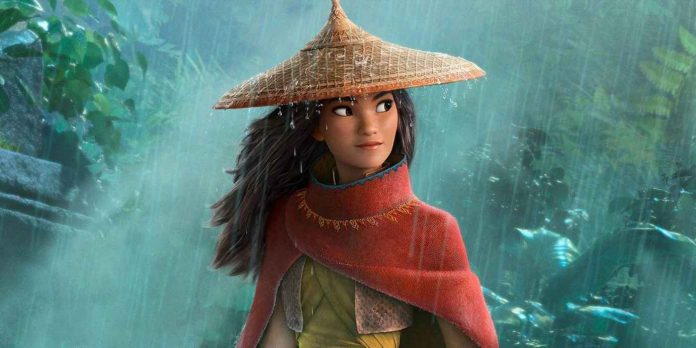Artnewspress:Raya and the Last Dragon debuts on Disney+ with Premier Access in most Disney+ markets, at the same time as it is released in theaters on March 5.
The film advances the groundwork laid by Frozen and Moana, which ushered in a modern era of princesses that weren’t romance-focused, but rather independent and intent on saving their people and their world. Where Elsa and Moana both spent their films growing into power, individuality, and freedom — each with their respective, earworm power ballads — Raya’s hero’s journey is marked by moments where she is challenged to make new friends, and rely on them to fight for her cause. By the end of the film, I had fallen in love with the character Raya had become and was fully invested in the friends she had made.
Raya and the Last Dragon’s framing around themes of trust breathes new life into the Disney animated action-adventure format. The waypoints along Raya’s hero’s journey each challenge her to be vulnerable with others — in addition to posing physical challenges, like swinging between ravines — giving the supporting cast real opportunities to shine, and Raya plenty of opportunities to outwit her opponents.
As Raya and dragon Sisu barrel through the regions of Kumandra (Tail, Talon, Spine, Fang, and Heart), their relationship deepens. This is also true of Raya’s confrontations with childhood-friend-turned-villain Namaari (who is also a princess). Each fight reveals something new about their rocky past, and how they might make amends. Scrapping romance gives Raya and the Last Dragon more space to give platonic relationships their due.
Raya and the Last Dragon is also one of Disney’s best films about grief. Disney’s princess films have always been about grief, as practically all of the princesses have lost a family member (or multiple) by the start of their movies. In prior films, these deaths mostly act as backstory and character motivation. By contrast, every single significant character in Raya and the Last Dragon has experienced devastating personal loss, is motivated by grief, and has spent a lot of time alone. Their decision to trust one another — to form a chosen family — feels much more meaningful with this weight.
Disney’s princesses have always had enormous sway in pop culture, particularly for American children. The toys, costumes, and music from any recent release can feel inescapable. Raya and the Last Dragon will give Southeast Asian girls not one but two princesses — both of whom are amazing fighters, and both of whom learn valuable lessons about leaning on friends and family for help. Before this, young Asian American Disney fans had Mulan, the well-loved classic that Raya and the Last Dragon effectively pays homage to without feeling recycled. (Some parallels with Mulan are obvious: a young woman using her fighting skills on a quest to protect her father, and a dragon companion voiced by a comedian.)
Of course, Raya and the Last Dragon is debuting to an audience with higher expectations around cultural representation than those who grew up with Mulan. At a moment where the number of Asian-centered films is steadily climbing, yet still limited — and where Southeast Asian actors are underrepresented in comparison to East Asian actors — this puts particular pressure on Disney’s first Southeast Asian princess.
Disney did a fair amount of research. Similar to Moana, Disney created what they call a “Story Trust” of artists, academics, and others, which they leaned on for issues of cultural accuracy. The team visited Southeast Asian countries, including Thailand, Vietnam, Laos, and Cambodia. Screenwriters Adele Lim and Qui Nguyen are both Southeast Asian, as is Kelly Marie Tran who voices Raya. But there’s the fact that most of the other voice actors — a packed roster of talent that includes Gemma Chan, Daniel Dae Kim, Awkwafina, and Sandra Oh — are East Asian. And because Kumandra is a “fantasy” world drawing from a number of different countries in a larger region, it risks blurring cultural references to the point where they become unrecognizable or incoherent to the people who expected to identify with the movie.
It’s a fine line to tread, and part of a larger conversation about the extent to which films featuring unrepresented ethnic groups are asked to carry the burden of “accurately portraying” that group. The idea that any one film, even if it meets the highest standards of research and casting, could capture “Southeast Asia” already falls apart. There is no single identity, as Southeast Asians aren’t a monolith. And like Mulan, this film mostly reads as distinctly American, with jokes about things like working on group projects at school that feel a bit out of place in a world that is supposedly fantastical.
It’s ultimately a film whose action and heart I really enjoyed, with a princess that I am genuinely excited about. It’s also a film that I hope to see in theaters. Tail, Talon, Spine, Fang, and Heart are each vibrantly animated. The frightening drune evokes the bubbling threats of Miyazaki’s Princess Mononoke. And fight scenes are particularly thrilling—the film’s fight styles are based on Muay Thai and Pencak silat, and grounded in real-world physics. When a character takes a punch, or when Raya parries with her father’s keris, it has a genuine weight that gives fights greater table stakes. Disney’s first Southeast Asian princess would only look even more powerful on the big screen.
Verdict
Raya and the Last Dragon is a beautifully animated, action-packed hero’s journey, and a great next evolution of Disney’s modern-day princess films. Where princesses like Moana and Elsa spent their films learning to trust in their powers, Disney’s first Southeast Asian princess Raya is already an excellent fighter, capable of besting even the strongest of warriors (including her nemesis and fellow princess Namaari). This gives the film space to focus on themes of trust, and the importance of finding a support system of friends and family, as well as truly tackling concepts like grief — the thematic mainstays of Disney’s princess films that haven’t always been adequately explored.
























